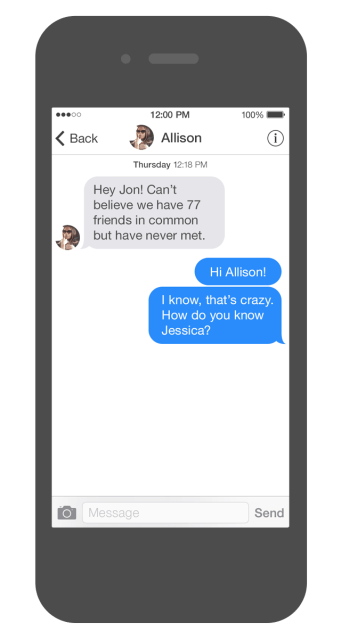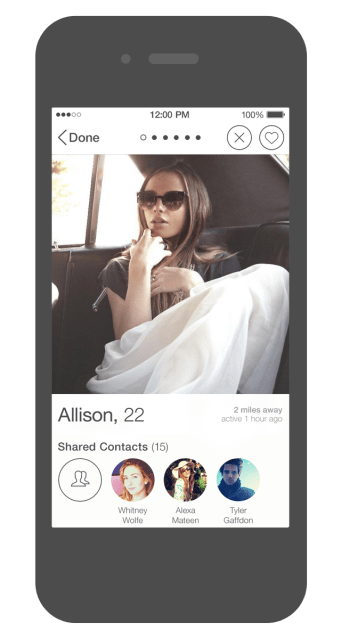<a target="_blank" href="http://www.gotinder.com/app/">Tinder, an app that allows you to swipe right on profile images in order to meet potential friends or dating prospects, has just launched its 3.0 version on Android and iOS. For those of you who want even more in common with the random people you meet through your mobile device, the new Tinder update will have a major revamp of its relevancy algorithm and add some key new features.
Wanting Tinder to be perceived as more than a dating app, cofounder Sean Rad has made the first product iteration towards a “for all” use case, adding a Tinder “lists” feature to its latest update. As you could probably glean from its name, the “lists” feature allows popular users to sort their scads of matches into lists, like “New York friends,” “LA friends,””Friends who like the color blue,” etc. Emphasis on friends here.
 You can add a user to lists by swiping right on people you’ve been matched with in the Tinder message center, and clicking the “Add to list” button, instead of “Block.” Or you could click on the native iOS button in the top-right corner of the message center, to go directly to lists.
You can add a user to lists by swiping right on people you’ve been matched with in the Tinder message center, and clicking the “Add to list” button, instead of “Block.” Or you could click on the native iOS button in the top-right corner of the message center, to go directly to lists.
In addition to Tinder lists and a “pumped up” redesigned swipe animation, the new Tinder app will allow for six optimized-for-hotness profile pictures, all visible at the same time.
Rad views the product update as Tinder’s first step towards creating a “graph of people you want to know,” referring to the opt-in feature as Tinder’s competitive advantage in the ambient location space. Apps like Highlight and Circle are attempting a similar feat, but without the double opt in advantage.
Eventually, Rad tells me, Tinder will create automatic, dynamic lists for users, based on its relevancy algorithm and user preferences, location and interests.
The “people you’d like to know” use case will leverage shared Facebook connections, interests and the straight up, superficial, “Hey, this looks like somebody I’d like to know” cues. The Tinder algorithm learns from your swiping behaviors and gets smarter about your preferences as you use it.
Rad hopes Tinder lists will help you make sense of your matches and increase user engagement beyond people who want to date (and even marry) through the app, no pun intended.
“You have certain co-workers, acquaintances, and whatnot, and it would be socially awkward if you added them on Facebook.” He brings up the example of a friend of his cofounder’s that he came across as he demo’d the app to me, Whitney. “It’d be weird to add her on Facebook, or follow on Instagram, but for the first time I can say ‘Hey Whitney, what’s up?” if we’ve both swiped right.
‘”That’s the breakthrough with Tinder,” he continues, “That signal has been gone until now.”
One might think that as the mobile dating space gets more crowded, Tinder would plant its feet firmly in the middle of it as newer dating use cases like Lulu gain momentum. But Rad wants everyone, taken, single, to be able to capture the graph of people they’d like to know — not just want to hook up with — through Tinder. And then allow you to better connect with those people.
It’s a risk to dilute what many view as Tinder’s core purpose, but Sean is not just paying lip-service to the vision. He has a significant other and still uses the app to meet and message with people, much like I do. Still, though I do use it, I’m not sure why people currently in relationships would want use the app every day. And when asked why he thought people would use it when they were already in relationships. Rad said, “I don’t know, but they are.”

When asked what he thought of competitors like Hinge or the Bang With Friends pivot, he said he wasn’t fazed by the existing competition, “A lot of companies taking inspiration from the double opt-in model. But we’re magnitudes larger than them. Just because you have the option to recreate something that already exists, doesn’t mean that you’re a competitor. We have a vision that’s clearly defined: We want to overcome all the issues of meeting new people, and focused on our own roadmap.”
Rad does, however, view the expansion of the dating app ecosystem as a net positive. “It’s interesting that there’s been a rise of these apps. If we have any part to do with that that’s humbling. But I’ll say we’re successful when we have the majority of the world’s population on Tinder. Every day there’s so many potential connections that are being lost.”

Some of the criticism I’ve heard about Tinder, which leaves a hole in the market for others, is about the effectiveness of its relevancy score versus being able to single swaths of people out like Hinge does, the ability to add a height or weight designation and the location issue. When you travel, you’re left scrolling through tens of remnants from your time in Berlin when you’re back in San Francisco.
“We’re well aware of that,” Rad responds, “And we’re fixing the experience for travelers. Lists and auto-lists are going to change a traveler’s life.”
Heavy travelers will also appreciate the fact that new Tinder now supports 24 new languages, including Simplified Chinese, Traditional Chinese, French, Russian, Japanese, Italian, German, Spanish, Swedish and (yes!) Greek.
According to Rad, Tinder is currently seeing 400 million swipes a day and 4 million matches per-day, up from 350 million and 3.5 million in October. The iOS app has been hovering towards the #10 rank in Lifestyle and #100 overall for about a year, according to App Annie. And there is a strong network effect that leads to more swipes and matches the more users join, though he wouldn’t reveal DAUs, MAUs or total number of registered users, even after much cajoling.
Tinder grew out of Hatch Labs, which was a part of IAC. It presently only has IAC as an investor, though we’ve heard rumors that many Valley firms want to swipe right hard.
Tinder is not planning on focusing on monetization anytime soon, but in-app purchases like stickers sent to people you’ve matched with seems like an obvious choice. Rad also says he might charge people to back swipe, in case they accidentally swiped left instead of right, “We would never add a pay wall to the core value, we want that to always remain free.”

Image via Flickr
